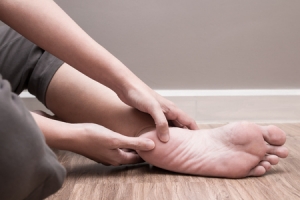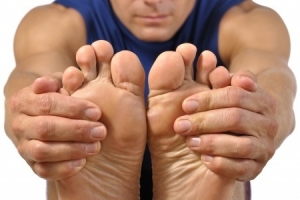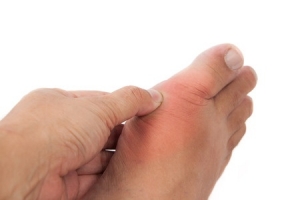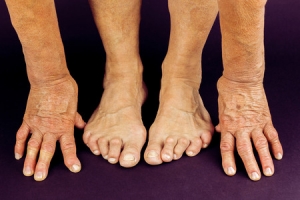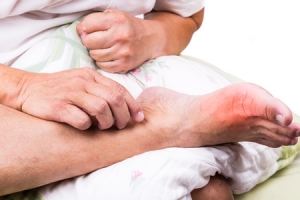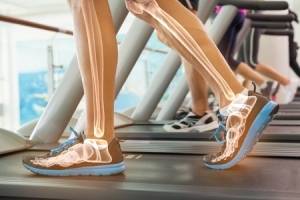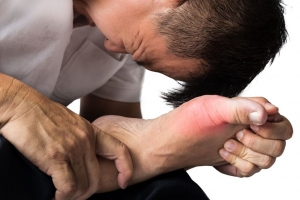Connect With Us
Blog
Displaying items by tag: Gout
3 Causes of Back of Heel Pain
At Superior Foot & Ankle Care Center we know that pain at the back of your heel can be quite debilitating. What starts as an annoying ache can quickly turn into excruciating pain that makes walking difficult. For our Los Angeles County patients that may be experiencing these uncomfortable symptoms, here are three possible causes.
Haglund’s Deformity—this is a bony enlargement that forms at the back of your heel. This condition may be the result of an inherited structural issue like a high arch or a tight Achilles tendon. It can also be caused by wearing shoes with stiff backs that rub on the heel—hence this deformity’s other name: pump bump.
Bursitis—small sacs that are filled with fluid—known as bursas—are found throughout the body near joints and bones. They serve as protection from friction and provide a little extra lubrication. When a bursa becomes irritated due to repetitive motion or pressure it can become painfully inflamed. Haglund’s deformity is one cause of bursitis but it may also be the result of repetitive action from exercise or another medical condition such as gout, diabetes or arthritis.
Achilles Tendonitis—this long tendon that runs down the back of your lower leg connects your calf muscle to the heel bone. It can be aggravated or injured from overuse such as someone whose job involves climbing a ladder. Athletes and “weekend warriors” who suddenly increase the intensity of their workout routine may also suffer from Achilles issues.
The only way to find out for sure what’s causing your back of heel pain is to let our podiatrists, Dr. Victoria M. Foley and Dr. Constance Ornelas, examine your foot and conduct the necessary tests to get to the bottom of the problem. You can contact our Long Beach office at (562) 420-9800 office for an appointment. To learn more about foot health and conditions we treat check out our video library.
Holiday Season Do’s and Don’ts for Healthy Feet
Although the radio may be proclaiming “It’s the Most Wonderful Time of the Year,” we at Superior Foot & Ankle Care Center know that the feet of our Los Angeles County patients may not agree. It’s a time of year with lots of extra errands to run, cooking and shopping to do, and being on your feet for longer periods than usual. However, you can sail through the season feeling “merry and bright” if you follow the do’s and don’ts below to keep your feet and ankles healthy and pain-free.
Do: go easy on holiday feasting. Yes, there will be lots of delicious sweets and treats on the menu, but come January extra weight gain could result in added stress and pain for your feet. Many common conditions such as plantar fasciitis, sesamoiditis, and metatarsalgia are all aggravated by carrying additional pounds. If you suffer with diabetes or gout, you need to pay particular attention to what you put on your plate. Go for small quantities of your favorites to savor and compensate by not loading up on unnecessary carbohydrates. Avoid going back for seconds!
Don’t: allow your feet to stay in damp socks. Whether you’ve stepped in a puddle or your feet are sweating during a long day of shopping, it’s essential to not let feet stay where it’s moist. Damp, dark, closed-in spaces (like the insides of your shoes) are the perfect breeding ground for fungal infections. Pack an extra pair of socks and change into them when you notice feet feel sweaty. Use foot powder before you put on socks.
Do: carefully consider footwear choices. When you know you’re going to be on your feet for several hours or doing an above-average amount of walking, make sure the styles you choose are comfortable and have good arch support and non-stick treads. Limit the amount of time in high-heeled party shoes!
Do: leave extra time in your schedule for making appointments. Rushing is when you’re most likely to not see an object in your path which can cause an ankle sprain or other injury.
Don’t: put off getting foot pain evaluated by our podiatrists, Dr. Victoria M. Foley and Dr. Constance Ornelas. This can result in a podiatric problem getting worse and potentially requiring longer and more invasive treatments. Make an appointment at our Long Beach office by calling: (562) 420-9800 today.
4 Common Foot Problems for Men
June is a month for celebrating men! At Superior Foot & Ankle Care Center, we want to recognize Men’s Health Month by highlighting some foot infections that afflict men. Studies show that men are less likely to be proactive and diligent about getting medical care. Encourage the men you love to get foot problems treated promptly by our podiatrists, Dr. Victoria M. Foley or Dr. Constance Ornelas. Below are some common podiatric issues men face.
- Haglund’s Deformity—while this condition, known as “pump bump,” it frequently affects men as well as women. Haglund’s deformity is a bony enlargement at the back of the heel that can become inflamed and irritated from the friction of stiff dress shoes and other footwear rubbing up against it. Bursitis can also develop because of Haglund’s deformity. The foot doctor will recommend shoe modifications, including changes in style and heel lifts or pads to help reduce friction. Icing and anti-inflammatory medications may be prescribed to relieve initial pain and inflammation.
- Gout—this painful, arthritic condition that usually strikes the joint at the base of the big toe is seen most often in men, ages 40-60. It is caused by too much uric acid in the body, which crystallizes in the joint. There are several potential sources of gout, and the podiatrist will help men who have suffered a gout attack before tracking down the cause. In many cases, certain foods can trigger an attack, and gout patients may need to avoid shellfish, red meat, alcohol, and rich sauces.
- Fungal Infections—regular exercise is a key component of a healthy lifestyle, but if the gym or community pool is the work site of choice, it’s essential to keep feet covered to avoid fungal infections like athlete’s foot and fungal toenails. These are passed on by direct contact. Places where people usually are barefoot and that are moist and warm are prime breeding grounds.
- Plantar Fasciitis—one of the most frequent causes of heel pain is plantar fasciitis. The plantar fascia is a long band of tissue that stretches along the bottom of your foot. If it becomes inflamed, heel pain may result. Flat feet and poorly fitting or worn out shoes are one common cause of inflammation.
Encourage your man not to ignore foot and ankle pain. Instead, make an appointment at our Long Beach office today by calling: (562) 420-9800 and get treatment before the problem worsens.
Losing Weight: Your Feet Will Thank You
It’s a sad fact that 74% of overweight Americans have foot problems. So, while you may wonder what the connection is, at Superior Foot & Ankle Care Center, we know there is a direct correlation between being overweight or obese and the health of your feet. It’s easy to see when you stop and think about it: your feet are carrying the weight of your entire body—the more you weigh the more stress and hard work for your feet. Below are three benefits for your feet to losing weight:
- Less foot pain—excess weight puts strain on your tendons and joints and can cause a flattening of the arch of your foot. This can increase your risk or the severity of several foot conditions, including:
- Plantar fasciitis
- Tendonitis
- Arthritis
- Sesamoiditis
- Gout
Changes and discomfort in your feet can also lead to problems with your back, hips and knees. If you are experiencing pain in any part of your foot, it’s essential that you make an appointment at our Long Beach office by calling: (562) 420-9800 so that our podiatrists, Dr. Victoria M. Foley or Dr. Constance Ornelas can examine your feet and determine the source of your foot problem.
- Prevention of diseases—maintaining a healthy weight can also help lower your risk of certain medical conditions such as diabetes, hypertension and peripheral arterial disease. These systemic diseases can have devastating affects on your feet like neuropathy and circulation problems.
- Greater mobility—the less you weigh, the easier it is to be active. Being active can help in losing and maintaining a proper weight. A regular exercise routine will also help keep foot joints flexible and preserve a full range of motion.
The good news is that it doesn’t require a huge drop in weight to see big results for your feet. For example, for every pound you lose, this reduces the pressure on your knees by up to four pounds. If you are concerned that your weight may be affecting the condition of your feet, contact us today for more information.
What Launches Gout Attacks?
Tis the season for cocktail parties, festive dinners, celebratory eating and—gout. At Superior Foot & Ankle Care Center, we expect to see more patients coming to us with gout at this time of year. We’ll often hear how after a holiday party they went home to bed only to wake up in the middle of the night with severe pain in their big toe. Although the foot was fine when they went to sleep, when they awoke in pain, they noticed that it was now swollen, red and hot. These are symptoms of a classic gout attack scenario.
The connection between feasting and gout is that there are several foods frequently found on holiday menus—red meat, shellfish, rich sauces, red wine, beer, and brandy–that are high in a chemical known as purines. Purines are also found in the body. When they break down, they produce uric acid. When there is an overabundance of uric acid in the body, it builds up in the joints where it can crystallize and bring on a gout attack.
Who’s at Risk?
Of course, not everyone who eats a slice of rib roast or has a glass of red wine gets gout. There are some patients whose bodies overproduce purines or have difficulty eliminating. They are therefore more sensitive to new purines entering into the body. Men aged 40-60 are the most frequent victims of gout attacks. In addition to foods, there are other factors that can increase the likelihood of gout, including:
- Heredity
- Obesity
- Stress
- Surgery
- Chemotherapy
- High blood pressure
- Diabetes
- Certain medications and vitamins
If you have suffered what you think is a gout attack, you’ll want to make an appointment at our Long Beach office as soon as possible. Our podiatrists, Dr. Victoria Foley, and Dr. Constance Ornelas will examine your foot and get a medical history from you. In addition, the foot doctor may order laboratory tests or x-rays to confirm a gout diagnosis. In the initial stages, the podiatrist may prescribe medication to relieve gout symptoms and recommend that you drink plenty of fluids and keep your foot elevated as much as possible. If gout proves to be a recurring problem, prescribing maintenance medication may be an option. To learn more, contact us by calling: (562) 420-9800.
Busting Arthritis Myths
May is a busy month for health observances but here at Superior Foot & Ankle Center, there’s one more that we can’t let pass by National Arthritis Awareness Month. Why are we so concerned about sharing information about this condition with our patients? With 33 joints in each of your feet, the effects of joint pain, swelling, inflammation and decreased range of motion can spell extreme debilitation if they attack your feet. Many people have some outdated ideas about arthritis, so we’d like to take this opportunity to expose some common myths:
Myth: Arthritis is a joint disease.
Fact: Actually, arthritis is a description of an entire category of more than 100 joint diseases. Besides the two best-known kinds—osteoarthritis and rheumatoid arthritis–many diseases you may be familiar with are considered forms of arthritis. These include chronic fatigue syndrome, gout, Lupus, Lyme disease and fibromyalgia.
Myth: Arthritis is an old person disease.
Fact: Approximately 300,000 babies, children and teens have arthritis. Although scientists are still trying to find out definitive causes of juvenile arthritis it’s thought that genetics and autoimmune diseases play a significant role.
Myth: Exercise is too painful if you have osteoarthritis.
Fact: Although patients with arthritis may worry that exercise will cause more harm to joints, it is the most effective non-drug treatment for improving movement and reducing pain caused by osteoarthritis. There are three types of exercise that are particularly beneficial: aerobic or endurance, flexibility and strengthening. Together these can greatly improve your range of motion and ability to move.
Myth: There’s no correlation between arthritis and the weather.
Fact: Although researchers have been skeptical in the past about the weather/pain connection, studies have confirmed that certain atmospheric changes do increase arthritis pain. Drops in barometric pressure and temperature cause greater joint discomfort. One study at Tufts University found that every 10-degree drop in temperature corresponded with an incremental increase in pain.
Myth: Arthritis is not a diet-related condition.
Fact: There are foods that cause an inflammatory response in the body and other foods that decrease inflammation. In addition, maintaining a healthy weight reduces the strain on the joints, particularly those in your feet and ankles.
To learn more about your risk for arthritis and the steps you can take to prevent it talk to our podiatrists, Dr. Victoria Foley or Dr. Constance Omelas at your next appointment. And if you start to experience any pain, swelling or joint discomfort, contact our Long Beach office as soon as possible by calling: (562) 420-9800.
3 Ways that Food Affects Your Feet
At Superior Foot & Ankle Care Center we know that the condition of your feet isn’t just about what goes on below your knees. Our podiatrists, Dr. Victoria M. Foley and Dr. Constance Ornelas believe that the health of the rest of your body plays a significant role in podiatric concerns. In honor of National Nutrition Month, we want to highlight the importance of proper eating and how it relates to your feet. Below are 3 ways that your diet can improve the health of your ankles and feet.
- Avoid Diabetes—diabetes, which afflicts over 30 million people in the U.S., affects your body’s ability to properly use or produce insulin resulting in high blood sugar levels. Diabetes reduces circulation and can cause neuropathy (loss of sensation) leaving your feet vulnerable to wounds and ulcers that can lead to infections and even possible amputation. The good news is you can prevent or significantly delay the onset of the most common form of this disease, Type 2 diabetes, with physical activity and modifications to your diet, including:
- Cutting way back on foods high in added sugar such as sodas and refined, processed foods
- Increasing the number of fruits, vegetables and whole-grain foods you consume every day
- Switching to healthier sources of fat such as olive and canola oil, nuts and avocados and avoiding saturated fats
- Prevent Gout Attacks and Inflammation—for patients who suffer from gout food is often what triggers an attack. Avoiding shellfish, red meat, beer, red wine, organ meats and heavy sauces can help you steer clear of this extremely painful joint inflammation which often happens in the big toe or ankle. Inflammation in, general, can be reduced by eating more berries, fish, and nuts high in omega 3 fatty acids, green vegetables, and olive oil, while steering clear of white sugar, fried food and refined flours.
- Decrease Your Risk of Foot Disorders—what do arthritis, plantar fasciitis, stress fractures and flat feet all have in common? The risk of developing one of these podiatric disorders as well as the severity of their symptoms are all increased by being overweight. There are many strategies for reducing and maintaining a healthy weight:
- Using smaller plates to automatically reduce portions
- Consulting a nutritionist or registered dietician to develop a healthy food plan
- Eat smaller portions more frequently instead of big meals
If you have questions about how changing your diet could impact a chronic foot condition contact our Long Beach office at 562-420-9800.
Eat this Not That During the Holidays
A common concern during this festive time of the year is navigating all the rich, calorie-laden holiday food offerings. From Christmas cookies to eggnog to roasts, to chips, dips, and other classic favorites menus can be landmines just waiting to blow up your healthy eating plan. At Superior Foot & Ankle Care Center we know that what you eat also impacts the health of your feet. Your feet carry the weight of your entire body and when you are overweight or obese you significantly increase your risk for several foot conditions and can make existing disorders much worse. In addition, foods can trigger an inflammatory response in conditions such as arthritis and gout.
If you have a podiatric condition that is associated with inflammation check with one of our podiatrists, Dr. Victoria Foley and Dr. Constance Omelas, about the best strategies for relieving or preventing inflammation. In some cases the foot doctor may prescribe medication or other treatments. If the inflammation seems to be increasing it’s important for the podiatrist to re-evaluate your condition to check its progression and rule out other complications.
Below are some healthful swaps to keep in mind as you make your way around the party buffet:
- Eat nuts and berries instead of chips and pretzels. Not only are nuts and berries healthier choices they also help fight inflammation whereas chips and pretzels are made with refined flour that can increase inflammatory response.
- If you are prone to gout eat chicken instead of red meat.
- Choose sparkling seltzer or wine spritzers over multiple alcoholic beverages. Excess alcohol intake can trigger gout, increase inflammation and pack on the pounds.
- Pick the smoked fish over the fried oysters. Fatty fish are known to decrease inflammation while fried foods increase it and are also are much higher in calories.
- Load up on greens and salads instead of potatoes and rolls. If you plate your salads and vegetables first there will be less room for higher calorie foods.
Healthy eating is just one way to protect your feet this holiday season. If you have questions about your feet and how to best care for them contact our Long Beach office by calling: 562-420-9800.
Focus on Joint Health
The joints in your feet—and there are 33 of them in each foot, by the way—are what allow your bones to glide over one another enabling you to do essential activities like walking, jumping and running. As we age, the cartilage in our joints can naturally start to breakdown resulting in bone rubbing on bone and causing painful conditions such as arthritis to develop. This week we celebrate Bone and Joint Health Awareness Week and at Superior Foot & Ankle Care Center we want patients to take a proactive approach to the health of their joints because of the big impact it has on your feet and the rest of your body.
Preventing Joint Problems
Although it’s true that the conditions that affect our joints, such as gout, arthritis and osteoporosis are not completely preventable, there are steps that patients can take at any age that will help ensure joint health now and in the future.
Be Active—physical activity actually helps protect your joints in a few ways. First, exercising regularly or participating in a sport helps build and maintain muscle which supports your joints. Exercise also helps you stay flexible—with joints, the saying “use it or lose it” definitely applies. Another benefit of being active is it can help you lose or maintain a healthy weight. Being overweight puts significant strain on the joints of your feet and other lower extremities, causing them to deteriorate faster.
Eat Purposefully—your diet also plays a big role in maintaining a normal weight. Fortunately, many of the aspects of a well balanced diet also improve joint health: avoiding sugars, processed foods, fried foods and refined flours can also reduce inflammation. Some studies show that there are some foods that fight inflammation. These include: berries, cherries, certain nuts and fish and leafy greens like kale and bok choy.
Guard Against Injuries—if you take a survey of adults with arthritis, many people will attest to the fact that a site injured in youth (knee, ankle, foot) later became a site where arthritis developed. Always wear protective gear for sports and warm up and stretch before exercise.
If you do sustain an injury, contact our Long Beach office right away by calling: 562-420-9800 so our foot and ankle surgeons, Dr. Victoria Foley and Dr. Constance Omelas can examine your foot or ankle. Prompt treatment and complete rehabilitation are two ways to guard against future joint injury and disease.
Does Your Foot Pain Signal a Serious Condition?
You might be surprised to learn that many diseases have foot pain as one of their symptoms. Problems with the thyroid can cause nerve sensations in the feet; or degeneration in the lower back might irritate the nerves of the spine, impeding sensation in the feet. Learning what signs to look for could improve your life or even save it.
Peripheral Arterial Disease (PAD)
PAD occurs when plaque – a fatty substance which builds up in the arteries in the legs – reduces blood flow to the lower legs and feet. Symptoms include cramping in the calves, or other parts of the leg while it is in motion. It may even cause foot pain, or prevent wounds in the foot from healing properly.
While the most obvious symptoms of PAD involve the legs, it is associated with hidden damage to the heart and brain. This means that PAD sufferers are at a higher risk of heart attack and stroke. Smoking, diabetes, high cholesterol, and high blood pressure will also increase the risk of PAD. Medications may be prescribed, but diet and lifestyle changes are also necessary.
Rheumatoid Arthritis (RA) and Gout
The Arthritis Foundation revealed that 46 million Americans have arthritis or other chronic joint problems. Of the 1.3 million Americans who suffer from rheumatoid arthritis, 90 percent of them will experience symptoms in their foot and ankle.
RA develops when the body’s immune system mistakenly attacks the joints, causing pain and swelling. If RA reaches the feet, pain will begin in the toes, and then spread to the feet and ankles later on. The joint damage caused by RA can even change the shape of the toes and feet, given enough time. RA treatment involves medication, exercise, and sometimes surgery.
Gout is another type of arthritis caused by the accumulation of uric acid in the body. The acid collects in the joints, especially the big toes, and will cause intense, episodic pain. The acid may even cause kidney stones if it builds up there.
Gout treatment involves exercise, lots of water, avoidance of certain medications, and staying at a healthy weight. Doctors may prescribe gout patients with nonsteroidal anti-inflammatory drugs (NSAIDs), steroids, or other medications.
Diabetes
Approximately 24 million Americans have diabetes, but 6 million don’t even know it. Diabetes is a condition in which glucose, or blood sugar, builds up in the blood. While glucose is necessary to fuel the body, an excess amount will damage nerves and blood vessels in the feet, causing decreased sensation and reduced blood flow.
Other symptoms of diabetes include numbness and tingling in the feet, and severe foot infections. While many people experience foot discomfort after a long day of standing, severe foot pain out of proportion with your activity level is a problem that should be reported to your doctor. Diabetes can lead to other major foot problems as well, and possibly surgical removal of the toe, foot, or lower leg.
Diabetes can be treated with medication and regular foot exams. It also requires lifestyle changes like quitting smoking, and wearing supportive shoes to mitigate foot trauma.
For more information on foot pain or to schedule an appointment, contact Superior Foot & Ankle Care Center.
Archives
Categories
- Featured (163)
- Blog (176)
- Ankle Care (6)
- Ankle Condition (2)
- Ankle Pain (0)
- Appointment Tips (2)
- Arch Pain (1)
- Arthritis (10)
- Athlete's Foot (6)
- Blister (1)
- Bunions (7)
- Calluses (1)
- Child Care (2)
- Circulation (1)
- Common Foot Conditions (4)
- Common Foot Problems (3)
- Corns (0)
- Custom Orthotics (1)
- Diabetes (10)
- Diabetic Foot Care (3)
- Diabetic Footwear (1)
- Edema (1)
- Exercise (4)
- Fall Prevention (1)
- Fitness (1)
- Flat Feet (2)
- Foot Care (19)
- Foot Care Safety Tips (3)
- Foot Care Tips (20)
- Foot Conditions (12)
- Foot Facts (3)
- Foot Health (6)
- Foot Odor (1)
- Foot Pain (5)
- Foot Problems (2)
- Foot Safety (1)
- Foot Surgery Tips (2)
- Foot Warts (2)
- Foot Wear (2)
- Fractures (1)
- Fungal Infection (2)
- General Health (0)
- Gout (5)
- Gout Treatment (0)
- Hammertoe (1)
- Health Tips (46)
- Heart Health (1)
- Heel Pain (0)
- Heel Spurs (0)
- Ingrown Toenails (4)
- Interesting Facts (2)
- Joint Pain (2)
- Leg Conditions (2)
- Leg Condtions (0)
- Men's Foot Health (1)
- Metatarsals (0)
- Nail Fungus (2)
- Neuropathy (1)
- Nutrition (2)
- Obesity (2)
- Osteoporosis (1)
- Pain Relief (5)
- Patient Communications (1)
- Pediatric Foot Conditions (5)
- Pediatric Foot Pain (2)
- Pedicure (1)
- Peripheral Arterial Disease (1)
- Plantar Fasciitis (2)
- Podiatrist Appointment (0)
- Pregnancy Feet (3)
- Proper Shoes (2)
- Senior Foot Care (7)
- Shoe Fit (1)
- Skin Cancer (3)
- Sports Injuries (2)
- Spring Foot Health (1)
- Summer Foot Health (2)
- Toe Pain (4)
- Uncategorized (5)
- Varicose Veins (2)
- Walking (1)
- Women Foot Health (3)
- Youth Sports (2)
